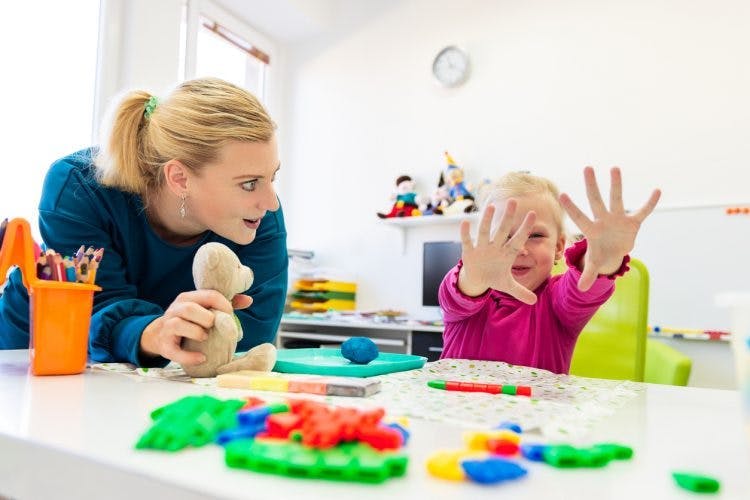Occupational therapy for cerebral palsy focuses on helping individuals become as functional as possible. It primarily involves practicing activities of daily living to help individuals develop the skills necessary to optimize their independence.
To help you understand the goals and techniques used by occupational therapists to help improve mobility and boost independence in individuals with cerebral palsy, this article will discuss:
- Goals of occupational therapy
- Occupational therapy activities for cerebral palsy
- Benefits of occupational therapy for cerebral palsy
- How occupational therapy can help individuals at any age
Goals of Occupational Therapy for Cerebral Palsy
Occupational therapy is a healthcare intervention that helps individuals optimize their independence by focusing on activities of daily living.
Unlike physical therapy (which focuses on improving flexibility, range of motion, and strength through exercise), occupational therapy primarily uses practical tasks and activities to prepare individuals with cerebral palsy for everyday situations. Although some traditional exercises may still be included during an occupational therapy treatment session, they are used as a means to an end result: increased participation in a valued activity. Occupational therapy can teach individuals how to:
- Perform self-care tasks (eating, sleeping, bathing, grooming, toileting, transferring, etc.)
- Use adaptive tools and mobility aids (to perform activities they otherwise may be unable to perform)
- Communicate with others and behave in a socially appropriate manner
- Manage sensory and emotional regulation needs
- Participate in school-related activities and play
Cerebral palsy describes a wide range of motor impairments at varying severities caused by damage to the developing brain. Because every case of CP is unique, occupational therapy for cerebral palsy must be tailored to each individual’s specific needs. Common motor impairments observed in individuals with cerebral palsy include abnormal muscle tone, posture, balance, and coordination.
An occupational therapist will assess the individual’s strengths, weaknesses, and personal goals, and then create an individualized activity program to develop their functional independence.
Want 19 pages of CP recovery tips in PDF form? Click here to download our free illustrated ebook now (link opens a pop up for uninterrupted reading)
The following section will share examples of activities an occupational therapist may have an individual with cerebral palsy practice.
Occupational Therapy Activities for Cerebral Palsy

At occupational therapy, individuals with cerebral palsy will utilize a variety of interventions and approaches to enhance their functional abilities.
Some examples of activities that may be practiced in an occupational therapy session for someone with cerebral palsy include:
- Turning a doorknob
- Putting away toys after play
- Clipping clothes pins onto surfaces
- Painting, drawing, and coloring
- Inserting and twisting a key to unlock/ lock a door
- Wiping down a table
- Flipping through the pages of a book
- Writing
- Waiting for their turn while playing games
- Typing on a keyboard
- Dressing (fastening and undoing a button; opening and closing a zipper)
- Using utensils with built-up handles
- Playing with playdough
- Participating in sensory activities
- Using silverware
- Developing a nighttime routine (brushing teeth, washing face, changing into pajamas, etc.)
- Moving around in a wheelchair or using other mobility aids
- Trialing equipment for safe transfers into/out of the shower, on/off of the toilet, etc.
- Putting orthotics on and off
- Practicing work-related tasks
Unlike traditional exercise, these activities are designed to be practical and have direct, real-world application. They’re also more likely to be practiced on a regular basis, which is key to promoting adaptive changes in the brain.
Neuroplasticity is the brain’s ability to reorganize its neural circuitry so that functions affected by damage can be rewired to unaffected regions and improved. Performing task-specific and highly repetitive movements stimulates the brain, reinforces demand for those functions, and encourages the brain to make adaptive changes. As a result, the more you practice, the more natural newly developed movement patterns will start to feel.
Up next, we’ll discuss some other major benefits of participating in occupational therapy.
Benefits of Occupational Therapy for Cerebral Palsy
Learning how to perform everyday tasks independently can boost an individual’s self-esteem and confidence. This will encourage them to continue to practice the repetitions they need to promote neuroplasticity and enhance their functional abilities.
By practicing occupational therapy activities, individuals with cerebral palsy may learn how to:
- Explore and interact with their surroundings
- Follow a routine or activity schedule
- Perform activities of daily living more independently
- Adjust and problem solve
- Improve gross and fine motor skills
- Modulate their sensory and emotional needs
Because the activities are personalized, task-specific, and practical, individuals will acquire skills that they will continue to use for the rest of their lives.
The following section will discuss how occupational therapy can be beneficial for individuals with CP at any age.
Why Occupational Therapy Can Be Beneficial at Any Age

Because individuals are either born with cerebral palsy or acquire it very early in life, they often participate in occupational therapy as children. Addressing your child’s needs early on may help them learn new skills and improve their motor impairments before abnormal movement patterns and habits develop.
Additionally, children’s brains have increased levels of neuroplasticity, meaning that they absorb information and pick up new skills quicker than adult brains. Unlike adults, children with CP don’t go to occupational therapy to recover essential skills, but rather to develop them for the first time.
However, occupational therapy can also be beneficial for adults with cerebral palsy.
Although the brain damage that causes cerebral palsy will not worsen over time, the secondary effects of cerebral palsy such as spasticity and pain can. As a result, you may experience new complications as you get older.
Periodic visits to an occupational therapist can help you address these new complications as early as possible and prevent them from interfering with your functional independence.
Occupational Therapy for Cerebral Palsy: Key Points
Occupational therapy can help individuals with CP optimize their functional abilities by practicing everyday skills and activities. These activities help individuals understand the real-world application of the movements they’re practicing and how they can help them develop their independence.
We hope this article helped you understand what occupational therapy for cerebral palsy may involve and its benefits.











